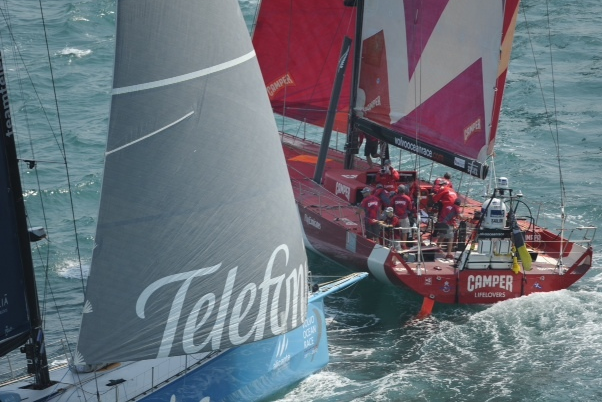Leg 4 from Sanya to Auckland started this morning, then stopped as racing was suspended in the face of boat breaking weather
It was another case of start/stop for the Volvo Ocean Race as the fleet started the 5,220 mile leg from Sanya to Auckland then stopped to wait for heavy weather conditions to pass in the South China Sea.
The race started at 1400 local (0600 UTC) but, after the normal short inshore course, instead of heading off on the long leg to New Zealand the fleet returned to the marina at Sanya to wait for what organisers said would be no more than 24 hours. The re-start was then to be staggered, with the boats leaving in the order they finished Stage 1.
The decision to place a break in the racing was taken by the race committee on Saturday to avoid what was described as ‘unsailable conditions’, with winds of over 40 knots and waves of up to 8 metres.
“We are doing this because of the weather advice issued by experts both from our own Race HQ in Alicante and the teams’ experts,” said race CEO Knut Frostad. “They all believe we have conditions which will be dangerous up to 12-18 hours after the Leg start, with waves that can break boats if you sail into them.
“This has been a very, very difficult decision for us which we’ve waited as long as possible to make so that we make the right one.”
Iker Martínez, skipper of overall race leaders Team Telefónica, said he supported the decision.
“We have to trust those forecasts,” he said. “It was very difficult to make this decision but it is clearly a case of safety first and we don’t want to go up against a wall.”
Memories of the last race when the fleet was decimated in the Strait of Luzon in some of the worst conditions of the entire event were clearly on the minds of the organisers. In addition, the track record of the current race must also have played a part in the decision where major breakdowns and a diminished fleet has played havoc with a race that is struggling to get into its stride.
Yet not all the competitors agreed with the race committee’s decision.
“Our strong preference was and remains for Leg 4 to start as intended,” said Camper’s skipper Chris Nicholson. “This is a fully professional race and ultimately we believe the decision on whether to start or not should be in the hands of the skipper.
“We’re professional sailors not professional risk takers and the reality is that the conditions our forecasters are predicting out there are manageable. None of our models are suggesting the 8 to 10 metre waves that I’ve heard being used to justify this decision.
“We believe there are several different options available for the fleet to deal with the forecast conditions and position themselves with in manageable wind and wave conditions. By short tacking up the shoreline we would most likely encounter 25 to 35 knots and 2 to 3 metre seas which this boat is more than capable of dealing with.
“As a team we built and designed a boat for these types of conditions and trained in them off New Zealand last winter knowing that we were likely to encounter them in this race. It is frustrating for all of us that this decision limits our ability to race the boat in the conditions we’ve prepared for.
“This is a professional around the world race and as such we need to be set to go to sea in rough conditions.
“All teams in this race have different agendas they’re trying to push on this decision but ours is pretty simply and up front – we’re well prepared and geared up for the conditions and we want to go sailing.”
Nicholson’s frustration was increased still further when it came to the start. In shifty and tricky conditions Puma and Camper led the fleet around the short inshore course, extending their advantage leg by leg. But after around 40 minutes of racing a problem with the deployment of their furling gennaker, Camper dropped from second to last.
But his team wasn’t alone in experiencing an afternoon of snakes and ladders fortunes. In a busy opening hour, Groupama hit the outer distance mark, Abu Dhabi went from third to last on leg three as they were forced to do a 720 penalty turn after a port and starboard incident with Telefonica before the fleet had a re-shuffle two hours into the race as the breeze turned inside out.
As the pre-amble to this leg played out, no one it seemed was immune to the lottery like weather conditions as the breeze switched on and off while swinging through large angles.
Despite having led from the start and extending their advantage with every turn, Puma’s impressive lead was slashed dramatically, two and a half hours into the race when Telefonica benefited from the best of the shifty conditions to take the lead.
A lead that come the re-start, could prove to be a significant advantage.
MATT’S BLOG
Is it right todelay the start of an offshore race? See my blog




